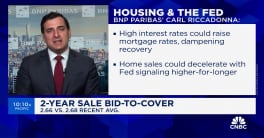The National Association of Realtors® (NAR) recently called on the Department of Housing and Urban Development (HUD) and the Federal Housing Finance Administration (FHFA) to reduce the owner-occupied ratio requirement for condominium complexes.
In letters to HUD Secretary Steven C. Preston and James B. Lockhart, III, Director of FHFA, NAR President Gaylord asked that the two agencies reduce the current requirement that 51 percent of individual units within a condo development be owner occupied for that unit to qualify for Freddie Mac, Fannie Mae, or Federal Housing Administration loans.
The Association also asked that bank-owned real estate resulting from foreclosures not be counted as non-owner occupied in calculating the 51 percent ratio.
The letters said that NAR recommends that the government sponsored enterprises (GSEs) reduce the occupancy ratio for GSE and FHA mortgages slightly "to a number below 50 percent for all condominium developments that have vacant units as a result of bank foreclosures. However, the number should not be reduced so much that it creates a development that is primarily investor-owned and harms the value or appreciation of owner-occupied units."
The loans meeting the rule of these agencies are generally the most accessible to borrowers and usually carry the lowest interest rates. Particularly in the current credit squeeze purchasers of condos may find it nearly impossible to arrange other types of funding.
Gaylord's letters said, "Amending the owner-occupancy rules for condominium developments for buyers with GSE or FHA mortgages will benefit all parties in the real estate transaction. Lenders will have the opportunity to move REO properties off their books because the units could be eligible for buyers with GSE or FHA mortgages. Further, individuals and families purchasing units in these developments with GSE or FHA loans will have access to more flexible and affordable financing opportunities." They "will have a wider choice of condominium developments. Finally, existing owners in these developments will benefit as vacant units are purchased and occupied and the owner-occupied ratio increases."
The last banking crisis in the late 1980s struck, at least in New England, on the heels of a frenzy of condominium conversions and construction which heavily targeted investors. Even the most upscale developments had investors who bought units (some costing over $350 per square foot) at pre-construction prices to hold for a few years and resell. On the lower end investors bought blocks of five, ten, or more units in older apartment buildings which were being "condominiumized." A common ploy was for the buildings' converters to offer the units for no money down, taking back what was often an illegal second mortgage equivalent to the downpayment. The profit margin on these conversions was so large that developers were not even particularly concerned about the junior liens being repaid.
When the crash came and the Federal Deposit Insurance Corporation (FDIC) became the owner of hundreds of condominium units throughout the region it found that very few of the foreclosed properties were in GSE or FHA approved developments because of the owner-occupancy ratio requirement. Many of the heavily investor-owned complexes, however, were virtually destroyed; unit prices had dropped to nearly nothing. One complex in Manchester, New Hampshire had been sold to investors in blocks of eight units for $54,000 per unit. A pre-foreclosure appraisal conducted for FDIC priced each unit between $5,400 and $7,000. Condo associations were unable to continue the most basic maintenance, and several complexes were so far-gone they were ultimately demolished.
The reduction of ratios requested by NAR are probably not so extreme as to cause these types of problems and may well encourage responsible investors to step up and take properties off of bank balance sheets. Getting individual units back into private ownership would also give condominium associations more control over collecting monthly fees which would stabilize building services and maintenance.
Perhaps, however, if HUD and FHFA do concede to NAR's request, they might consider making the reduction in owner-occupied ratio temporary, so as not to create a second wave of investor-generated nonsense eight or ten years down the road.







